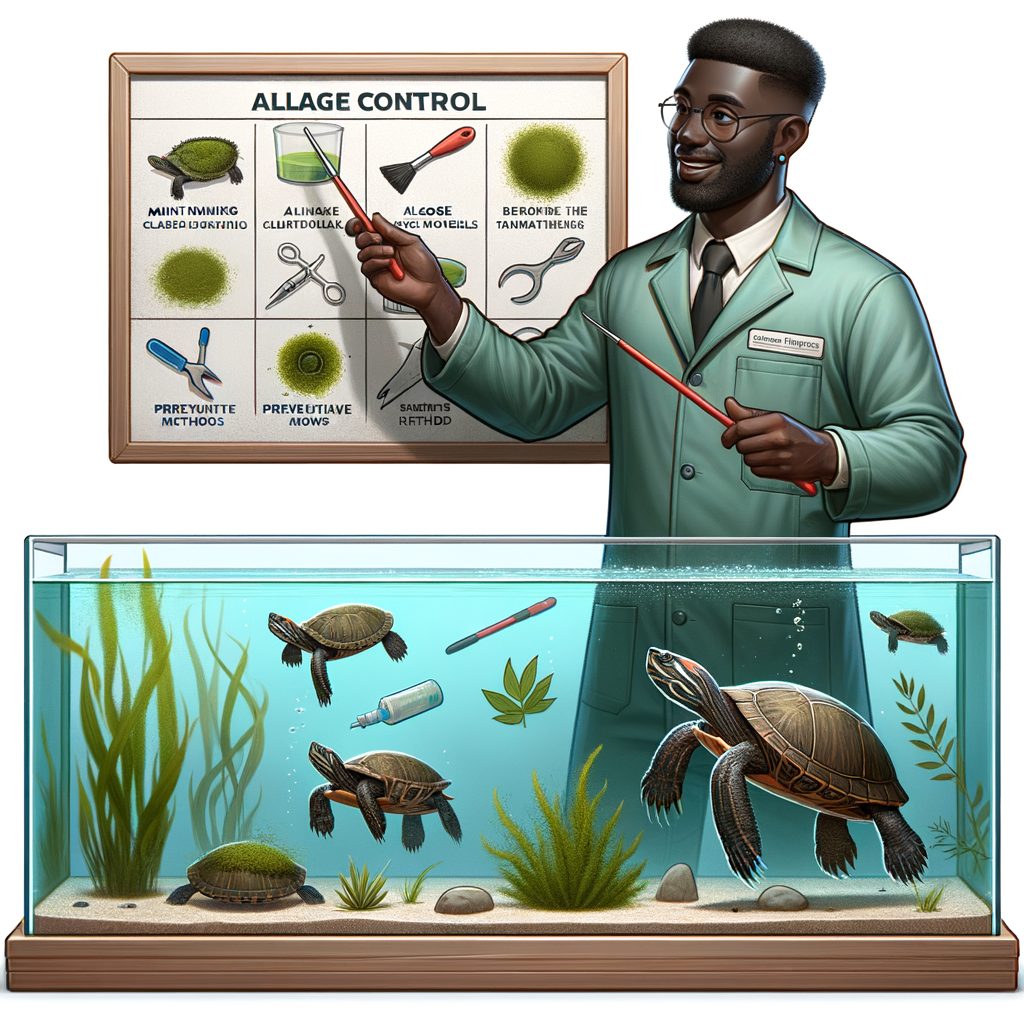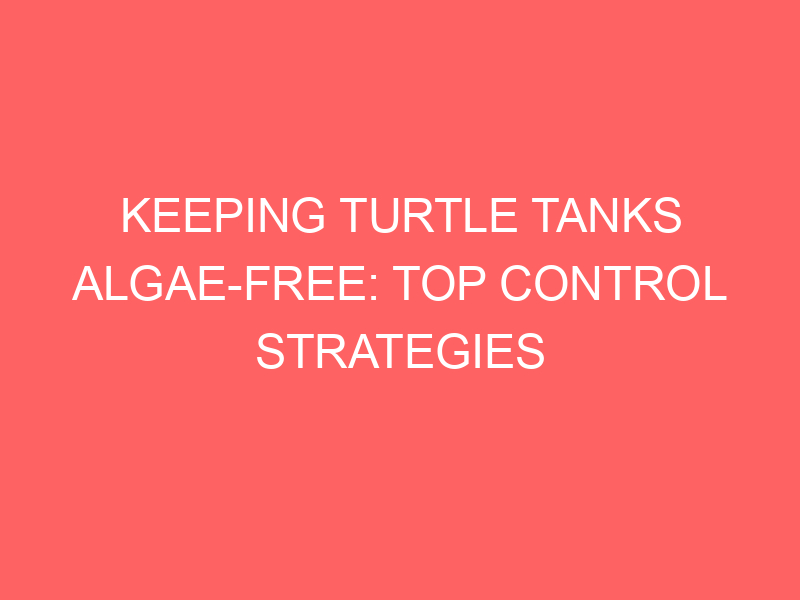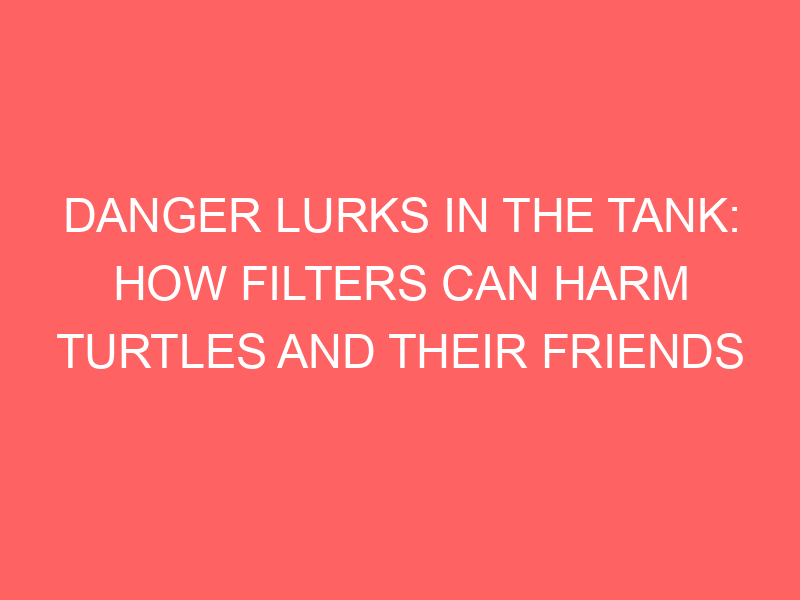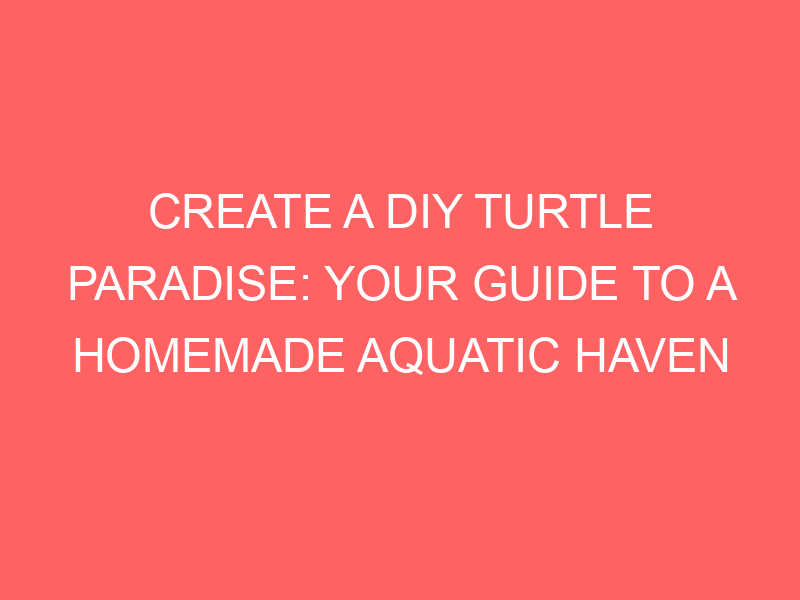
Introduction to Turtle Tank Algae Prevention
Keeping a turtle tank clean and free from algae is not just about aesthetics. It’s about creating a healthy environment for your pet turtle to thrive. In this section, we will delve into the importance of algae control in aquariums and explore the common causes of algae growth in turtle tanks.
- Understanding the Importance of Algae Control in Aquariums
- Common Causes of Algae Growth in Turtle Tanks
- Excessive Light: Algae require light to photosynthesize and grow. If your turtle tank is exposed to too much light, especially direct sunlight, it can lead to an algae bloom.
- Overfeeding: Uneaten food and waste can decay in the tank, producing nutrients that algae feed on. Overfeeding your turtle can therefore contribute to algae growth.
- Poor Water Quality: If the water in your turtle tank is not regularly cleaned and filtered, it can become a breeding ground for algae.
Algae is a common issue in both freshwater and saltwater aquariums. While a small amount of algae can be beneficial, providing food for certain species and aiding in the natural filtration process, an overgrowth can cause serious problems. Excessive algae can deplete oxygen levels in the water, leading to a harmful environment for your turtle. It can also block light from reaching other plants in the tank, hindering their growth and overall health. Therefore, controlling algae growth is essential to maintaining a balanced and healthy turtle tank.
Understanding the causes of algae growth is the first step to preventing it. Algae thrive in certain conditions, and by controlling these, you can manage the algae levels in your turtle tank. Here are some common causes:
By understanding these causes, you can take proactive steps to prevent algae growth and maintain a clean, healthy environment for your turtle.
Pristine Turtle Tank Maintenance: Key Factors
Keeping a turtle tank clean is essential for the health and happiness of your pet. In this section, we will discuss the importance of regular cleaning and provide effective strategies for maintaining a pristine turtle tank.
Maintaining Clean Turtle Tanks: Regular Cleaning
Regular cleaning is a crucial part of turtle tank maintenance. Let’s delve into why it is so important and how you can do it effectively.
- Importance of Regular Cleaning
- Effective Cleaning Strategies for Turtle Tanks
- Regular Water Changes: Replace 25% of the tank water with fresh, dechlorinated water every week. This helps to dilute waste and reduce the buildup of harmful substances.
- Use of a Good Filter: A powerful filter can remove waste and debris from the water, keeping it clean and clear. Ensure the filter is cleaned regularly to keep it functioning effectively.
- Scrubbing the Tank: Use a tank brush to scrub the walls and bottom of the tank at least once a month. This helps to remove any algae or bacterial buildup.
- Regular Tank Checks: Regularly check the tank for any uneaten food or waste and remove it promptly. This prevents the growth of bacteria and keeps the water clean.
Regular cleaning of your turtle tank is not just about aesthetics. It plays a vital role in the overall health of your pet. A dirty tank can lead to the growth of harmful bacteria and algae, which can cause various health issues for your turtle, such as skin and shell infections. According to a study, 70% of turtle health problems are due to poor tank hygiene.
Now that we understand the importance of regular cleaning, let’s look at some effective strategies for keeping your turtle tank clean:
By following these strategies, you can ensure a clean and healthy environment for your pet turtle. Remember, a clean tank is a happy tank!
Controlling Algae in Turtle Tanks: Correct Lighting
Lighting plays a crucial role in controlling algae growth in turtle tanks. Let’s explore how lighting affects algae growth and how to choose the right lighting for your turtle tank.
- How lighting affects algae growth
- Choosing the right lighting for your turtle tank
- Choose a light that emits less red and blue light: As mentioned earlier, algae thrive on red and blue light. By choosing a light that emits less light in these wavelengths, you can help control algae growth.
- Limit the amount of light: Turtles need about 12 hours of light each day. By turning off the tank light at night, you can help prevent excessive algae growth.
- Consider using a timer: A timer can ensure your turtles get the right amount of light each day. It can also help prevent algae growth by ensuring the tank isn’t lit for too long.
Just like plants, algae use light to photosynthesize, a process that helps them grow. The brighter and longer your tank lights are on, the faster algae can grow. However, too much light can also harm your turtles, as they need a balance of light and dark periods for their health and well-being.
It’s important to note that not all light is equal. Algae prefer certain wavelengths of light, specifically in the blue and red spectrum. If your tank light emits a lot of light in these wavelengths, you may be inadvertently encouraging algae growth.
Choosing the right lighting for your turtle tank is a balancing act. You need to provide enough light for your turtles without promoting excessive algae growth. Here are some tips:
In conclusion, the right lighting can make a big difference in controlling algae growth in your turtle tank. By understanding how light affects algae and choosing the right lighting, you can create a healthier environment for your turtles.
Algae Removal in Turtle Tanks: Practical Techniques
Keeping a turtle tank clean is essential for the health and happiness of your pet. One of the most common issues turtle owners face is the growth of algae. Algae can be harmful to turtles and can also make the tank look dirty and unattractive. Let’s explore some practical techniques for algae removal in turtle tanks.
Turtle Tank Cleaning Strategies: Manual Removal
Manual removal is one of the most effective ways to get rid of algae in your turtle tank. This method involves physically removing the algae from the tank. It may require some effort, but it’s worth it to keep your pet’s environment clean and healthy.
- Steps for manual algae removal
- First, remove your turtle and place it in a safe, temporary container.
- Next, drain the water from the tank.
- Using a scrub brush, gently scrub the sides and bottom of the tank to remove the algae.
- Once you’ve removed as much algae as possible, rinse the tank thoroughly with clean water.
- Refill the tank with fresh water and return your turtle to its home.
- Tools and equipment for effective algae removal
- A scrub brush: This is essential for scrubbing off the algae. Choose a brush with stiff bristles to effectively remove the algae.
- Aquarium vacuum: This can help you clean the gravel and remove any algae that’s settled there.
- Algae pads: These are specially designed pads that can help you scrub off stubborn algae without scratching the tank.
Here are the steps you can follow to manually remove algae from your turtle tank:
Having the right tools can make the process of removing algae from your turtle tank much easier. Here are some tools and equipment that can help:
Remember, manual algae removal is a crucial part of maintaining a clean and healthy environment for your turtle. Regular cleaning can prevent algae from building up and becoming a problem. So, roll up your sleeves and get scrubbing!
Turtle Tank Algae Solutions: Chemical Treatments
Chemical treatments are a practical technique for controlling algae in turtle tanks. They play a crucial role in maintaining a clean and healthy environment for your turtles. Let’s delve into the details of how these treatments work and which ones are safe and effective for your turtle tanks.
- Understanding the role of chemical treatments in algae control
- Safe and effective chemical treatments for turtle tanks
Chemical treatments are used in turtle tanks to control the growth of algae. Algae, while a natural part of any aquatic ecosystem, can overgrow and cause problems if left unchecked. Algae can cloud the water, make it hard for turtles to see, and even deplete the oxygen levels in the water. Chemical treatments work by targeting and killing the algae, thereby preventing these issues.
When it comes to choosing a chemical treatment for your turtle tank, safety should be your top priority. Not all chemicals are safe for turtles. Some can harm their health or even be fatal. Therefore, it’s essential to choose treatments that are specifically designed for use in turtle tanks.
One safe and effective treatment is the use of algaecides. Algaecides are chemicals that kill algae and prevent their growth. They come in various forms, including liquids and tablets. When used correctly, they can effectively control algae without harming your turtles.
Another safe treatment is the use of ultraviolet (UV) sterilizers. UV sterilizers work by exposing the water to UV light, which kills algae and other microorganisms. They are safe for turtles and can be very effective in controlling algae.
In conclusion, chemical treatments can be a useful tool in controlling algae in turtle tanks. However, it’s essential to choose treatments that are safe for your turtles and use them correctly. Always follow the manufacturer’s instructions and consult with a professional if you’re unsure.
Keeping Turtle Tanks Algae-Free: Long-Term Strategies
Keeping your turtle tank algae-free is not just about short-term cleaning and maintenance. It also involves long-term strategies that can help prevent the growth of algae in the first place. One such strategy is choosing the right tank mates for your turtle.
Algae-Free Turtle Tank Tips: Choosing the Right Tank Mates
Believe it or not, the companions you choose for your turtle can play a significant role in controlling algae growth. Let’s explore how this works and which tank mates are best for this purpose.
- How tank mates can help control algae growth
- Best tank mates for algae control in turtle tanks
Some aquatic creatures are natural algae eaters. They feed on algae, thereby controlling its growth in the tank. By choosing such tank mates for your turtle, you can maintain an algae-free environment without resorting to chemicals or constant cleaning. It’s a natural and effective way to keep your turtle tank clean.
There are several types of fish and snails that can help control algae growth in turtle tanks. For instance, Plecostomus (also known as Plecos or Algae Eaters) are a type of fish that feed on algae. Similarly, Nerite Snails are well-known for their appetite for algae. However, it’s crucial to ensure that these tank mates are compatible with your turtle species. Always consult with a pet expert or do thorough research before introducing new creatures into your turtle tank.
Remember, keeping your turtle tank algae-free is not a one-time task but a continuous process. By adopting these long-term strategies, you can ensure a healthy and clean environment for your turtle.
Turtle Tank Cleanliness: Regular Water Changes
Keeping your turtle’s tank clean is crucial for their health and happiness. One of the most important aspects of this is regular water changes. Let’s explore why this is so important and how you can do it effectively.
- Importance of regular water changes in preventing algae growth
- Best practices for changing water in turtle tanks
- Remove your turtle: Before you start changing the water, make sure to safely remove your turtle and place them in a secure, temporary container.
- Drain the tank: Use a siphon or a bucket to carefully remove the old water from the tank.
- Clean the tank: With the water out, now is a good time to scrub the tank and remove any algae or waste. Use a turtle-safe cleaner and rinse thoroughly.
- Refill the tank: Add fresh, dechlorinated water to the tank. Make sure the water is the right temperature for your turtle.
- Return your turtle: Once the tank is clean and refilled, you can safely return your turtle to their home.
Algae is a common problem in turtle tanks. It can make the water look dirty and can even harm your turtle’s health. Regular water changes are one of the most effective ways to prevent algae growth. By replacing the old, algae-filled water with fresh, clean water, you’re removing the environment that algae need to grow. This can significantly reduce the amount of algae in your tank.
Changing the water in your turtle tank isn’t as simple as just pouring out the old water and adding in new. There are a few best practices you should follow to ensure the process is effective and safe for your turtle.
By regularly changing the water in your turtle tank and following these best practices, you can help keep your turtle’s environment clean and algae-free. This is a key part of maintaining a healthy, happy habitat for your turtle.
Conclusion: Ensuring a Healthy, Algae-Free Environment for Your Turtle
In this guide, we’ve explored the importance of maintaining a clean, algae-free environment for your turtle. Let’s take a moment to recap the key strategies and underline the significance of consistent maintenance for achieving this goal.
- Recap of top strategies for turtle tank algae prevention:
- Importance of consistent maintenance for algae-free turtle tanks:
Firstly, we discussed the importance of regular water changes as a fundamental strategy for preventing algae growth. We also highlighted the role of a balanced diet in maintaining the water quality in your turtle tank. Furthermore, we emphasized the use of algae-eating creatures and UV sterilizers as effective methods for algae control.
Consistent maintenance is the cornerstone of an algae-free turtle tank. Regularly cleaning the tank, monitoring the water parameters, and promptly addressing any signs of algae growth can ensure a healthy environment for your turtle. Remember, an algae-free tank is not just about aesthetics, but it’s also about the health and well-being of your pet turtle.
In conclusion, maintaining an algae-free turtle tank may require some effort, but the rewards are well worth it. By following the strategies outlined in this guide, you can provide a clean, healthy habitat for your turtle, ensuring its long-term health and happiness.
Remember, every turtle deserves a clean, algae-free home. Let’s make it happen!














